When Kirsty from Little Shop of Horrors first contacted me, I was intrigued by what she had to say about the Etsy product we were discussing. My mind was sent racing about what Kirty said and about how I could do an article based on this product, Inner Demons, as it would be my first such article.
Disclaimer: I was gifted this item to do the review, but all thoughts are my own and I don’t profit from you visiting their store or any purchase you may make thereafter.
The Birth Of The Inner Demons
Kirsty, from the Little Shop of Horrors is a long-term sufferer of obsessive-compulsive disorder (OCD) and its various subtypes, as well as also having anxiety. But because of the pandemic, Kirsty wasn’t unable to attend therapy or her OCD group meetings. Not being able to go to therapy affected Kirtsy so badly she didn’t know what to do with herself, as she couldn’t cope with her various intrusive thoughts due to having no outlet for them.

At some point during the middle of the pandemic last year, Kirsty needed to focus her mind on new avenues of interest because there weren’t the usual daily distractions she could rely on. Kirsty has always been a keen crafter, which eventually led to her taking up needle felting. One day, out of nowhere, she created her first Inner Demons in a bottle that was supposed to represent her inner demons and mental health.
Kirtsy told her husband about her Inner Demons creation and he suggested it might be a good idea to talk to it, to use it as an outlet. Although Kirtsy was unsure at first, that uncertainty soon went away when she found that it did actually help her to have something small and physical to shout at and to talk to.
What Are The Inner Demons?
The Inner Demons are little needle felted demons that are presented in a jar that represents the physical manifestations of our own personal demons. Your own inner demon could be depression, bipolar, anxiety, an eating disorder, etc. but the whole idea of these small physical manifestations is that you have something to take your pain out on rather than expressing it towards others or inwardly towards yourself.
The Inner Demons are designed with the instruction that you talk or shout at them when times are bad, whereby you tell them just how bad they’re making you feel. With them being small in proportion to the owner, it also allows you to feel physically and mentally more empowered and in control rather than feeling dominated by their own mental health.
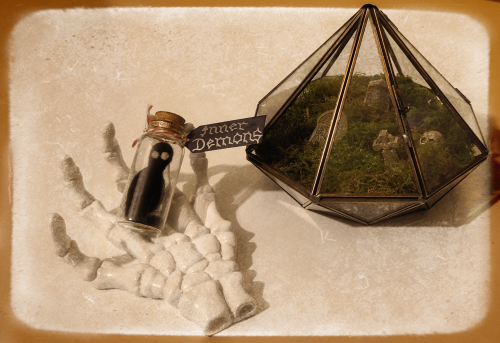
What The Research Says
After talking to Kirsy and hearing her story, I decided to do a bit of research to see if I could support the concept. The following is what I found.
Benefits of talking to yourself aloud
Thought suppression is a common method used to try and control unwanted thoughts. I know it was something I did when trying to control my anxiety-induced psychotic episodes. But it never helped me. In fact, it always made things worse for me. My biggest success was letting my thoughts run their course.
Wegner, Schneider, Carter, and White (1987) conducted two experiments to investigate thought suppression. The results of this study indicated that the act of suppression can have the opposite effect. When someone tries to get a particular thought out of their mind, they often give that thought more power. Even if that person is eventually able to suppress that thought, it often comes back in a moment of weakness, which can cause an unusual preoccupation with that thought, causing the thought to grow. In some cases, this new preoccupation with that thought can cause it to become an obsessional thought. I think this is exactly how my anxiety thoughts became so overwhelming.
A study by Tolin, Abramowitz, Przeworski, and Foa (2002) into the intrusive thoughts of those suffering from OCD also reached the same conclusion. This is further supported by a review of thought suppression by Wenzlaff and Wegner (2000), who stated that this form of mental control helps assure the very state of mind the person suppressing their thoughts is trying to avoid.
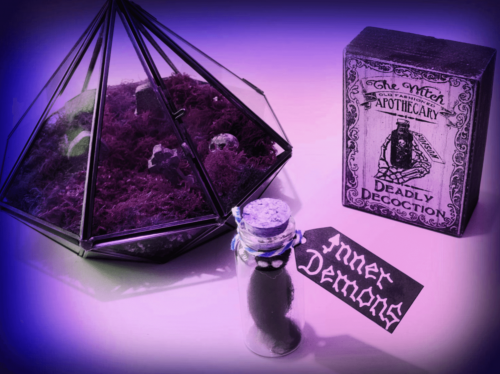
Another way you could deal with these intrusive thoughts or your other negative thoughts could be to verbalise them by talking to your Inner Demons to let them know you’re the one in control, not them. Basically, talking to your Inner Demons would function in much the same way as journalling about what’s bothering you, accept instead of writing it down you’re vocalising it, making your Inner Demons the representation of your inner turmoil through the use of treating it like a spoken journal.
Furthermore, according to Shine, research has shown that talking to yourself out loud, or your Inner Demons, can help combat your self-criticism. Plus, talking out loud to manage difficult emotions like anger, stress, and sadness can help you work through them. The reason it helps, according to Dr Nicolosi (NBC News), is because the act of speaking aloud slows down our thoughts and causes us to process them differently. This slowing process then stops our inner thoughts from making us feel like we’re being bombarded by them, reducing the chances of us feeling overwhelmed by the thoughts we’re struggling with.
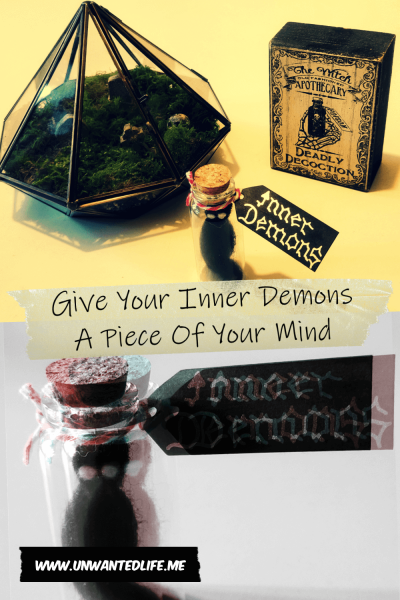
Using your Inner Demons as a spoken journal is also like writing something down and then destroying what you wrote as a way to release what’s bothering you. The reason this can work is that our brains don’t always create a clear distinction between the mental and physical (Psychology Today). Thus, talking to your Inner Demons fulfils much of the same strategy because once you’ve said it out loud, the evidence of what you’ve said is also gone.
According to the study by Briñol, Gascó, Petty, and Horcajo (2013) on objectifying thoughts, they found that when their participants physically discarded a representation of their thoughts, they mentally discarded them as well, but they also found that even mentally imagining doing this was effective as well. Therefore, making your Inner Demons the focus of what you’re saying when you vent your thoughts will also be cathartic.
Also, just to put your mind at ease, talking to yourself, or your Inner Demons, is normal. We often engage in verbal self-talk without really noticing we’re doing it to help motivate ourselves (Boroujeni and Shahbazi, 2011), help with memory (Lupyan and Swingley, 2012), and to help with completing tasks (Kirkham, Breeze, and Marί-Beffa, 2012).
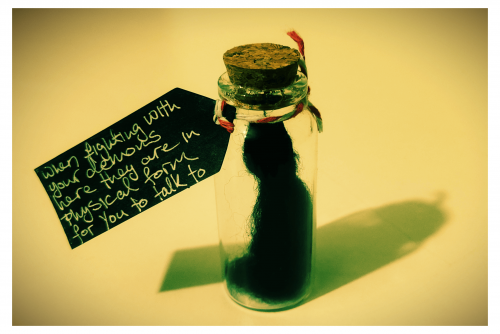
Benefits of shouting/screaming
You could even take this up a notch by screaming and shouting at your Inner Demon. Screaming into a pillow is a very common way to manage anger and frustration, so why not release that pent-up emotion at your Inner Demons instead? I know screaming (or “scream-singing” if you will) along with my favourite metalcore bands helps me feel better.
[Screaming] creates a chemical reaction that is similar to the one you get when you exercise—you get a dopamine hit and some endorphins going
However, be mindful of screaming and shouting at your Inner Demons, because if people don’t know that’s what you’re doing, it might cause those that hear you to feel concerned. So give your family the heads up if you’re going to try out screaming or shouting at your Inner Demons.
My Inner Demons Review
The Inner Demons as a literal representation of your inner demon(s), that are trapped inside a bottle and under your control, is a cute idea. The idea of making the representation of your Inner Demons into a spoken journal to improve your mental health is novel and creative, and the research suggests it might work.
All in all, I’m not used to talking aloud about my problems at the best of times, if they’re not a professional counsellor of some description. I’ve also never been comfortable shouting, no matter the reason, but I guess that’s my anxiety disorders for you.
But I did try talking to my Inner Demons so I could write this review. However, it was a strange experience to talk to my little Inner Demons. Because it’s not something I’ve ever done before. It kind of reminded me of how I try to study for my exams to get around my dyslexia, where I’d write my notes in bullet points in different coloured pens, read through them, and then read through it a second time but this time reading it aloud. I found it a little awkward then, and I still find it a little awkward now. But I’m sure as I get used to talking to my Inner Demons, the less weird I’ll feel about it.
That said, personally, I found it too weird and difficult to shout at my Inner Demons. That’s just something I wouldn’t really do, especially as I live with housemates. I don’t want to freak out the random people I share my living situation with.
Nevertheless, I love the concept and can really see the merit in the Inner Demons product, although it might take me a while to get used to talking to it, and I may never shout at it. As a goth at heart, the Inner Demons really appeals to me and I would buy it for that reason alone, purely for its aesthetic appeal. I can’t tell you just how much the goth in me really loves the Inner Demons. It’d be great if there was a version of the Inner Demons that was safe to have as a keyring or could be worn as a necklace.
Because my goth heart finds this item so adorable, I’m giving it 5/5.

What makes the Inner Demons item even better is that it’s also very inexpensive, so if you’d like to purchase your own Inner Demons, you can do so by clicking here or clicking the image below.
Kirsty also says that every time someone buys their own representation of their Inner Demons, a donation is made to OCD-UK. So buying one for your self-care and wellbeing will also help a good cause.
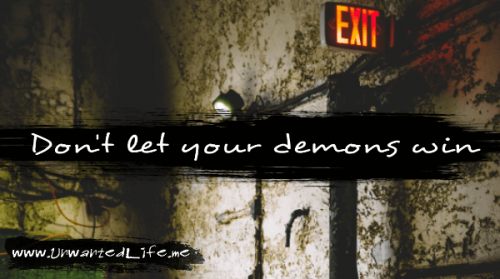
As always, leave your feedback in the comments section below. Also, feel free to share your thoughts on the Inner Demons Kirsty has created in the comments section below as well. If you want to stay up-to-date with my blog, then sign up for my newsletter below. Alternatively, get push notifications for new articles by clicking the red bell icon in the bottom right corner.
Lastly, if you’d like to support my blog, then you can make a donation of any size below as well. Until next time, Unwanted Life readers.
References
Briñol, P., Gascó, M., Petty, R. E., & Horcajo, J. (2013). Treating Thoughts as Material Objects Can Increase or Decrease Their Impact on Evaluation. Psychological Science, 24(1), 41–47. Retrieved from https://doi.org/10.1177/0956797612449176 and https://www.researchgate.net/profile/Pablo-Brinol/publication/233774775_Treating_Thoughts_as_Material_Objects_Can_Increase_or_Decrease_Their_Impact_on_Evaluation/links/54d269280cf28e06972415d0/Treating-Thoughts-as-Material-Objects-Can-Increase-or-Decrease-Their-Impact-on-Evaluation.pdf.
Boroujeni, S. T., & Shahbazi, M. (2011). The Effect of Instructional and Motivational Self-Talk on Performance of Basketball’s Motor Skill. Procedia – Social and Behavioral Sciences, 15, 3113-3117. Retrieved from https://doi.org/10.1016/j.sbspro.2011.04.255.
Kirkham, A. J., Breeze, J. M., & Marί-Beffa, P. (2012). The impact of verbal instructions on goal-directed behaviour. Acta Psychologica, 139(1), 212-219. Retrieved from https://doi.org/10.1016/j.actpsy.2011.09.016.
Lupyan, G., & Swingley, D. (2012). Self-directed speech affects visual search performance. The Quarterly Journal of Experimental Psychology, 65(6), 1068-1085. Retrieved from https://doi.org/10.1080/17470218.2011.647039.
Tolin, D. F., Abramowitz, J. S., Przeworski, A., and Foa, E. B. (2002). Thought suppression in obsessive-compulsive disorder. Behaviour Research and Therapy, 40(11), 1255-1274. Retrieved from https://doi.org/10.1016/S0005-7967(01)00095-X and https://d1wqtxts1xzle7.cloudfront.net/49402634/Thought_suppression_in_obsessive-compuls20161006-29481-ovdr1h.pdf?1475765243=&response-content-disposition=inline%3B+filename%3DThought_suppression_in_obsessive_compuls.pdf&Expires=1614790993&Signature=JrTpF3zchYr1boyG6yaQQJIvcCQ62YlY4EbQ1FxBonfQU7BqPb-HgqJq6rKD5HQQvYA-6Nqwckc6R95PzzDWUyGHczcYF572N-dnugniZHSS3S1dmfor6lRGiSm-jwtX3wAm8xvFJ8lir2EviJOv30gabun5kJfE8tPRHuU2iFuUQZKas8LMBQ4vkodA-C4fCvBkGZEtt2dOR~8F-fvei4mSahIvF2Y46qokuEnec34U8wUM1zh9Vkz3bdCQKHpHwdlA~9lYEj8G53g5DOYhDUj1aA6FYVkMz4G4KlH4ycOGHcesovPU~c0oe2uGSDnAmgDyRWoZcADKE0d0dpyngQ__&Key-Pair-Id=APKAJLOHF5GGSLRBV4ZA.
Wegner, D. M., Schneider, D. J., Carter, S. R., & White, T. L. (1987). Paradoxical effects of thought suppression. Journal of Personality and Social Psychology, 53(1), 5-13. Retrieved from https://wjh-www.harvard.edu/~dtg/DANWEGNER/pub/Wegner,Schneider,Carter,&White%201987.pdf and https://www.demenzemedicinagenerale.net/images/pdf/Tought%20suppression%20(orso%20bianco).pdf.
Wenzlaff, R. M., & Wegner, D. M. (2000). Thought suppression. Annual Review of Psychology, 51(1), 59-91. Retrieved from https://doi.org/10.1146/annurev.psych.51.1.59 and https://grupoact.com.ar/wp-content/uploads/2020/06/2000-Thought-suppression-Wenzlaff-Wegner.pdf.
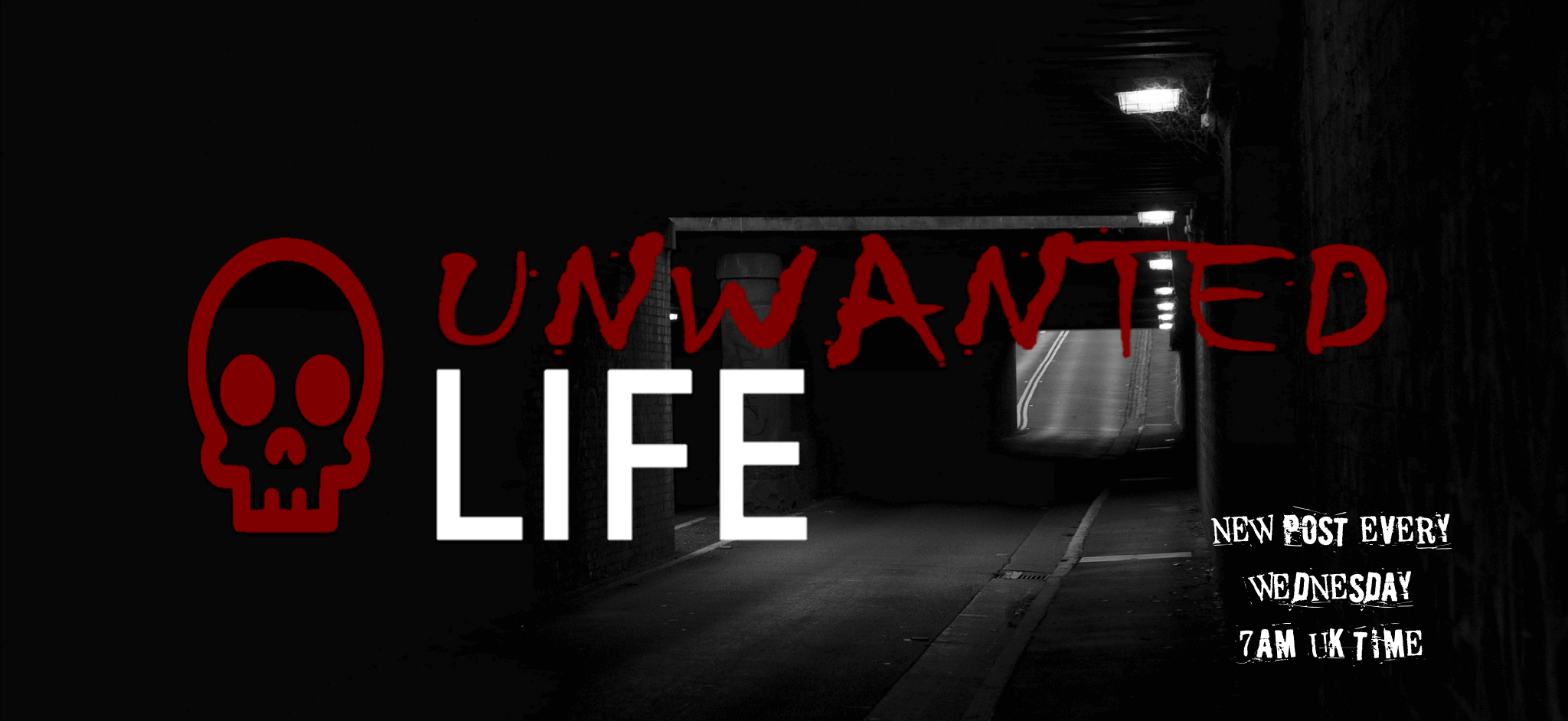
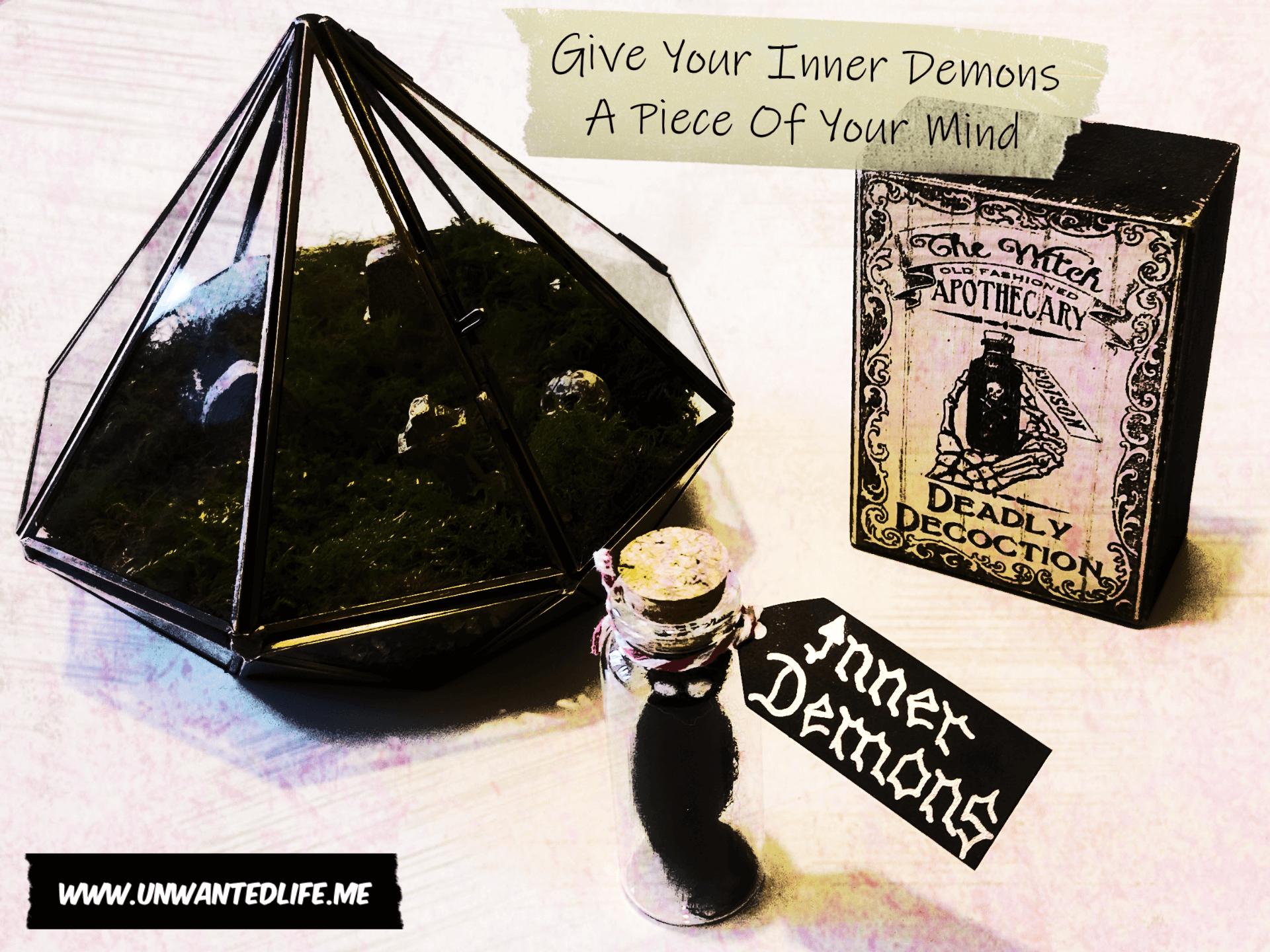
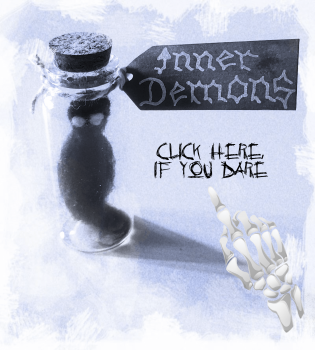
This is such a great and unique idea! I think that having a representation of what you feel inside can help a lot in expressing ourselves and coming face to face with it! Thank you for sharing!
Indeed. Thanks for commenting
What an unusual idea.
Unusual can often be good ?
This sounds like such an interesting product, and it’s so important to express ourselves when we might be feeling something negative. Thank you for sharing
I sure found it interesting ?
Wow Ok I love the idea of this. I read something recently that really made me re-evaluate the way I speak to myself and about my own body!
I like the idea of this but I think it’ll take some retraining of my brain!
Rosie
We all need to retrain our brains from time to time
What a cool product. Kristy is very creative. I’m glad she discovered a way to reduce her anxiety. My mother also likes to shout at herself every time she is angry at her own carelessness. That’s how she let things go.
I wish I was able to be as creative as Kristy
Great post! It resonated so much with me. Thanks for a truly great read!
Louna | burstsofautumn
Thanks for commenting
I love this concept! I still remember during my therapy sessions for my eating disorder, they had us name our disorder so that we could talk to it as a way of encouraging us to quantify our feelings and emotions. It felt so good to finally be able to tell ‘it’ exactly what we were thinking and how we felt about the impact that it had on our lives. I wish that it didn’t cost so much to have things shipped from the UK to Canada, or I’d pick one up!
Were you encouraged to talk to your eating disorder, that you’d named, out loud? What did you name it, out of interest?
First off I LOVE the name of Kirsty’s shop! I like the idea of having an inner demon to talk to about my problems, but I wouldn’t be comfortable shouting at it either since I live in an apartment
It really is a great name isn’t it
The title of this post really caught my attention. Inner demons can be destructive if they get out of control or if we can’t let it out. I think we all have them. Journaling really helps if you don’t talk about it to anyone. That product also works as a representation that they are small and should not overpower us.
I’m glad the title caught your attention ?
I LOVE this idea and how Kirsty has used her creativity to bring healing to so many. Brilliant! Although, like you, I’m not into shouting except on rare occasions; talking back to those lying thoughts and letting them know who is the boss is very helpful. Journaling out loud is a good way to put it.
I do agree about how thought suppression is really not that effective. When we stop and think about it – you have to think about the thought to actively suppress it. We are essentially obsessing over the thing we’re trying not to obsess over. 🙂 What we give our attention to grows. It certainly makes my anxiety worse when I’m trying not to think on something that I’m thinking about.
Thank you for sharing Kirsty with all of us!
I think that’s how some people might end end becoming addicted to substances, as they seek a different way to silence the thoughts they want to avoid
I am not in the habit of shouting to myself nor to other people – I can imagine though that trying to repress thoughts doesn’t help because I tried that with diets – the more I didn’t want myself to think about food the more I thought about it 🙂
Surprising thoughts really doesn’t seem to work at all
Great product concept. Thank you for sharing 🙂
Thanks for commenting
Inner Demons look amazing. I think it’s great that Kristy was able to work through some of her OCD and anxiety stress by shouting or talking to her inner demons. I bet these will help a lot of people.
I’m sure people would benefit from owning one
What a fabulous concept Kirsty has taken created something wonderful here! I love this idea of sharing your problems and anxieties with inanimate objects. I can imagine this will be a great form of therapy for so many! xxx
I’m sure a lot of people would get something out of doing that
What Kirsty has created is pretry dope! And this article was such a good read. I’m literally always learning something new from you and I’m appreciative of that.
The concept is unusual, but at the same time, it’s good to change the narrative of our life to get better results. I love the idea of screaming and the similaritirs it has to exercising in terms of releasing the same chemicals. I am not a screamer lol, but may be this is something I need to try to help get my emotions our of my system much quicker.
Thanks for sharing ?
It never hurts to try something new. The new thing you try might just turnout to be extremely useful to you
This is such a cool and unique idea. I love it! I am so bad at talking out my thoughts. I feel like this would be a great visual reminder to do so instead of keeping them bottled up. Thank you for sharing!
I don’t know how I didn’t even think of that, that the Inner Demons would also work as a visual reminder. Great insight
This is such a great idea! I’m not sure I’d want to shout at it, but I probably would talk to it and tell it how it’s making me feel!
I love the honesty of your review, thanks for sharing, I’m off to check out the website ? xx
Holly | https://www.gollymissholly.uk
Thank you and thanks for checking out her store
This looks like such a useful way of venting and expressing yourself!
Indeed ?
What a great way of expressing yourself. I guess it is very much like talking therapy, apart from you are talking to the inner demon, rather than someone else. Very interesting post!
Aimsy xoxo
Thank you and thanks for commenting
I am way too familiar with inner demons! I find exercise and meditation helps me. Not sure I could shout but maybe next time I’m plagued, (like in the next 5 minutes!) I’ll try it. Thanks for the great research.
Always worth a go
Really original idea ?
Thanks for sharing
https://uncuaderno4cero.wordpress.com/
Indeed it is
What a wonderful idea. Many years ago I manifested my demons into a game whereby I wanted to take back control. I soon discovered that the very thing that was trying to usurp me also wanted to enjoy the things that I wanted to enjoy, so I did a deal and I challenge myself to receive evidence of all the stuff that the voices say I can’t do. I challenge my demons now on most days, and explain to it that if I win, then so does the demon. Yes, this is talking to myself, but rarely shouting, sort of coming to an arrangement. I need my darkness along with my light, it makes me whole, and I really love this idea. So well done to her and to you for writing about it here. Thank you.
I’m glad you’ve found a way to work with your inner demons
This is such a good idea – having something to physically represent your mental and emotional states is such a powerful thing.
Indeed. Thanks for commenting
Love this idea and so great to have a creative outlet 🙂 When I couldn’t get counselling & lost mental health support, I talked to myself a lot and it sounds weird but almost tried to counsel myself? It rarely worked but it was good to get things off my chest. I found that too with writing, sometimes it did get worse but on occasion it got better. And being in that situation and feeling terrible, if it sometimes works, I want to keep trying.
I’ve often used counseling on myself, which I actually found more effective than the actual counseling I got
This is a very cute idea and I definitely see how it could work. I talk to my hamster when I’m frustrated, so it’s actually not that different. Thanks for sharing!
Hamsters are so adorable as well
This is very interesting and such a creative solution. I’m glad to hear that she was able to help herself as well as others.
And you know, I’ve never thought of the concept of a spoken journal. But that’s also a very good idea.
Great piece!
A spoken journal is an interesting idea
What a cute little fella! I don’t think I would be able to shout at him either, but it would be nice to have a little void to speak to whenever I need it. What a neat idea x
The Inner Demons are super cute aren’t they
Great post! Thanks for sharing your thoughts on this product!
Thanks for commenting
I’ve always had a loud vocal dialogue with my faults, flaws, mistakes, imperfections…inner demons…I guess. I thought that was the norm up until recently. At first, I thought maybe I was nuts, but I love the idea that talking to them/journaling with them is healthy! In truth, I couldn’t imagine my life without the voices in my head; they bring me peace in their own weird way. Will you continue to practice journaling/dialogue with your inner demons?
Thanks for sharing. Honestly, I’m not sure if I will continue to talk to my Inner Demons or not, living in a shared household with strangers makes me a little concerned to do so as I don’t want them to hear. Plus, I’m not very good at forming new habits, I’m still trying to get my yoga habit to stick at the moment
I love it! What an awesome idea. And, like you, my inner-goth wants it just to have it on the shelf!
It is goth-tastic
I am so intrigued by this! I love the concept of having an inner demon quietly contained in hand, and love even more that Kristy was able to help herself by channeling some of her feelings into something as creative as this.
I do not mind admitting I find these little felted fellows just a touch cute, which makes them even more faceable.
Thanks so much for sharing! 🙂
Thanks for commenting on these dark little cuties
Interesting! I didn’t it could come with weakness. It’s surprising to know about the experiments as well. Thank you for sharing and taking the time to do the research helping her!
Thank you
These inner demons are scary. Even more scarier when we don’t know how to handle them. Verbalizing them is an effective tip! THanks for sharing! Learned a lot.
http://www.lifebeginsattwenty.com
Thanks for commenting
I really, really love the idea about Inner Demons. I agree, that also for me it would be pretty strange to talk with my inner demons, but what I like is the main idea…. it reminds me, that we all have our inner demons inside of us, but it doesn’t mean, that we need to let them out, it doesn’t mean that we can’t control them!
And also the price for this sweetie is more than friendly!!!!
Indeed ??